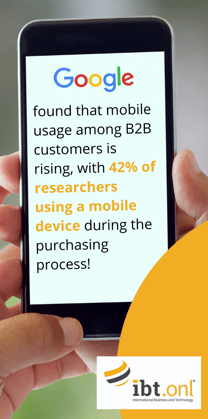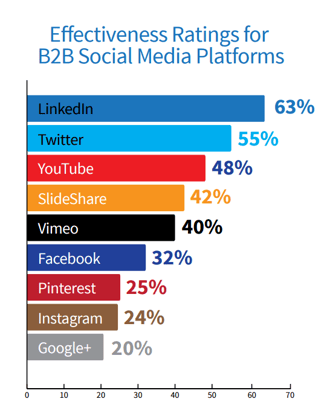.png?width=385&name=b2b%20marketing%20blog%20Hero%20image%20(1).png)
HubSpot’s INBOUND2021 was yet again a great opportunity to learn, connect and sit back and think about how the world (digital and not) is changing.
As a marketer, one of the main takeaways from a number of the sessions I had the pleasure to attend and engage with was the accelerated changes in B2B marketing trends.
Historically, B2B marketing has always been perceived as, literally, “Business to Business” hence pushing messages heavily focused on hard metrics like ROI, profitability, and sales.
Well, the way businesses thrive has not changed and these metrics continue to be what drives the bottom line, but what has become more apparent is that the way we convey our messages must change.
Why? Here are 3 reasons to consider:
- There is always a human being on the other side of the channel
Regardless of what industry you operate within, each communication and sales are done with a real person – and although the B2B decision-making process involves a much higher number of parties than the B2C counterpart, each individual you are dealing with have stressors they need to alleviate, problems they are looking to solve.
As Trever Ackerman, CMO at WellBizB Brands excellently describes in her Forbes article “B2B businesses, generally speaking, have been late to the party in realizing that there are emotion-driven human beings at the end of their customer journey touch points”.
Your job as a B2B marketer is to understand what their ‘stressors’ are and show them you are not there to waste their time, but you can provide a solution.
- Your B2B prospects now expect a personalized experience
We all feel that we’re spending our lives in the office – whether that is now our kitchen table or a ‘real’ office – but don’t forget that the human being on the other side of the table (not your kitchen table in this case!) is continually exposed to brand marketing, they shop online all the time, and they now expect the same from their providers and business partners.
- The rise of the Mobile-first experience

Let’s be honest, there is a very high chance you’re reading this on your mobile device. Or, if not, it’s not been long since you browsed your email or news on it.
We have all heard the expression “mobile-first”, and with the changes to the way we work over the past 18 months, over 80% of B2B buyers now reportedly use mobile at work, with 50% of all online queries today were made on a smartphone.
And yes, this includes your prospects and business partners.
So, how can B2B marketers tackle these new trends?
1. Understand who you are talking to – Build your buyer personaRegardless of whether your audience is B2B or B2C, you still want to put yourself in their shoes, think about their pain points, and how your brand’s solutions can help.
The best way to ensure you have a good understanding of who you are trying to reach, and indeed what their pain points are, is to establish who your Buyer Persona is – or are!
As HubSpot defines it, a buyer persona is “a detailed description of someone who represents your target audience. This is not a real customer, but a fictional person who embodies the characteristics of your best potential customers.”
Things to consider when creating your buyer persona are: age, location, language, interests, challenges, decision-making power, size of business, etc.
The good news is that you most probably already have a lot of information on them, but don’t hesitate to get all your teams together – sales, operations, senior management – as they might all have more to offer!
And beware, you might (and probably should!) have more than one buyer persona, especially if you are doing business in multiple international markets.
2. Be helpful
Oracle reports that “60% of B2B customers prefer not to communicate with sales as a chief source of information and that an even higher percentage of customers would rather conduct their own independent research online”.
So how can you get all your information in front of your prospects? Content marketing and great website content is key. By producing, sharing, and promoting content that prospects can easily find and consume at their own pace you can ensure your prospects will find you, understand you and perceive you as their trusted partner, even before starting doing business with you.
New to content marketing? Find out more about why this is.. well, king in our blog!
3. Invest in your website and marketing strategy as your #1 sales rep!
a) The rise of mobile
With working habits shifting due to COVID19, and more and more businesses adopting a more ‘flexible’ approach, mobile has seen an accelerated adoption rate in the B2B realm. Google found that mobile usage among B2B customers is rising, with 42% of researchers using a mobile device during the purchasing process and 49% of researchers who use a mobile device for product research do so at work (Forbes).
What does this mean for you? With more users browsing on mobile phones, you must ensure your website is fit for purpose, mobile-responsive, allowing your users to browse all your content and, maybe even more importantly, get in touch with you with the same ease as they would on their good old desktop.
b) Don’t discount Social Media
It’s not uncommon, and we see this every day, for B2B businesses to be skeptical, at least initially, about taking their brands and products to Social Media. But building a social media presence is a huge part of brand building, and according to research by Omobono, social media is equally as important for B2B marketing. In a survey of marketing professionals in B2B roles, 79% rated social media as their most effective marketing channel.
And why is this, you wonder? Remember, there is always a human being at the other end of every marketing channel you use, and they are now expecting to be communicated with in a different way.
However, taking your brand to social media does not necessarily mean that you must spread yourself across all possible platforms from LinkedIn to Weibo to TikTok! The quality of the content you share is just as important as your target audience.
And let's not forget that often (and depending in which regions) your social media presence is a way to reassert and validate your business - not only individuals but also other companies will look at your presence on social media channels as a way to vouch for your credibility and reputation in the market
 To make sure you are always communicating with the right audience, at the right time, with the right message, make sure you know who your buyer persona is, how do they consume information online, and which platform they engage with – this will give you a great starting point.
To make sure you are always communicating with the right audience, at the right time, with the right message, make sure you know who your buyer persona is, how do they consume information online, and which platform they engage with – this will give you a great starting point.
So, how do we move forward?
Why do we keep talking about B2C and B2B if they are becoming so similar? Well, despite the similarity there are still some meaningful differences. Doing business with another company usually involves a more complex and layered decision-making process, with a much higher number of stakeholders involved, and change can be perceived as a threat, rather than an advantage.
But fear not, by understanding the customer journey, remaining agile across your platforms and content, and aligning B2C and B2B tactics your marketing efforts can become incredibly powerful.
With all of this in mind, at IBT Online we continue to develop and improve our Online Global Marketing program to better serve our partners, by leveraging the power of digital tools to help companies grow their exports, sales, brand, and business globally.
Curious to see what that can look like for you? Just get in touch!
Sources:
https://blogs.oracle.com/marketingcloud/post/how-to-make-b2b-marketing-content-more-like-b2c


